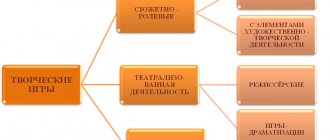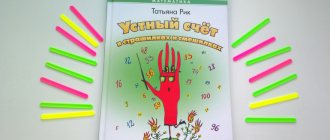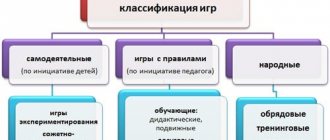Pedagogical principles of organizing story-based games in kindergarten.
Pedagogical principles of organizing story-based games in kindergarten.
The teacher must help the child master gaming skills by involving him in the game. Principles for organizing a story game in kindergarten: 1. The teacher should play with the children. 2. The teacher should play with children throughout preschool childhood, but at each stage, develop the game in a special way, so that the children immediately “discover” and assimilate a new, more complex way of constructing it. 3. Starting from an early age and further at each stage of preschool childhood, when developing gaming skills, it is necessary to simultaneously orient the child both to the implementation of a gaming action and to explaining its meaning to partners - an adult and a peer. Organization of the game in the first junior group
At an early age, children need to develop the ability to carry out a variety of conditional play actions. The formation of a story-based game should be carried out against the background of the teacher’s constant organization of conditions for elementary substantive interaction of children with each other. To do this, use any “rolling” objects (ball, cart, etc.), which stimulate children to imitate, mirror actions directed at each other. Further joint play between the teacher and children with the aim of forming substantive interaction can take other forms: joint construction of a tower from cubes, assembling a pyramid, etc. In parallel with the formation of objective interaction in pairs of children, the teacher must solve the problem of forming a conditional play action that replaces real action with “real” things. The teacher’s task is to develop in a child by the age of three the ability to develop conditioned actions with a plot toy, a substitute object and an imaginary object, connect two or three game actions into a semantic chain, verbally designate them, continue the meaningful action started by an adult partner, and then peer. To successfully develop gaming skills in young children, the teacher needs to develop a joint game with children, consistently changing the nature of the child’s participation in it: 1) involve the child in carrying out a conditional action with story toys that is necessary within the meaning of the game; stimulate him to continue, to complement the meaning of the play action of the adult partner; 2) involve the child in carrying out a conditioned action with substitutes and imaginary objects; 3) orient the child to continue, complement the play action of the peer partner, stimulate the verbal designation of play actions. The teacher can check the progress of children in mastering gaming skills by observing their independent activities. If children, in independent play, develop chains of 2-3 actions with story-based toys, include individual substitute objects in the game, naming actions with them, and can, with the help of a toy or a short verbal address, evoke a response play action from a peer - we can consider that the simplest play their skills have been developed.
Organization of the game in the second junior group
By the age of three, children have developed a conditioned objective action, through which the child develops independent play. Actions with “make-believe” objects prepare the child for the possibility of understanding that he himself can be someone else in the game – a “make-believe” mother, a doctor, etc. A three-year-old child becomes able to master a role - a more complex semantic and structural “node” of the game. The skills that children must master in order to fully use the role as a specific way of building a game: 1) be able to take on a play role and designate it for a partner; 2) be able to carry out role-specific conditional objective actions and be able to deploy specific role interaction - role dialogue; 3) be able to change role behavior during the game depending on the roles of the partners; 4) be able to change your playing role depending on the unfolding plot. The teacher’s task when working with children of the 4th year of life is to build a joint game with them in such a way that role-playing behavior becomes its central point. The child’s attention must be transferred from actions with toys to interaction with an adult partner. By responding to the role-playing requests of an adult, entering into a role-playing dialogue initiated by him, the child will “discover” the convention of his own position (role) in the game, previously hidden for him by actions with toys. The simplest role imitation can occur in a child in relation to any social role, a fairy-tale or literary character, which is unpredictable. The teacher’s task is to “guess” what the child is doing, connect to his play, finding an additional role that is appropriate in meaning, and acting “from within” it, develop role interaction. The goal of the teacher is not to unify, to bring uniformity to the play of all children, within the framework of “given” plots and roles, but to develop the play of each child based on his personal interests. The significance of playing together with an adult is that now, in children’s free independent play, actions with toys will be more closely accompanied by role-playing dialogues, naming their role to a peer partner and role-playing address to him will appear: children will more freely enter into play contacts and develop role interaction with each other. The plots of the game that an adult develops with children of this age should be simple - monotonous and built mainly on paired roles that are closely related in meaning. Indicators of the success of the formation of role behavior in children of the 4th year of life are the following: the development by children in independent activities of specific role actions and role speech aimed at puppet characters, paired role interaction with a peer, including the name of their role, role appeal, short dialogue. Organization of the game in the middle group
The teacher’s tasks in working with children of the 5th year of life are to transfer them to more complex role behavior in the game: to develop the ability to change their role behavior in accordance with the different roles of partners, the ability to change the game role and indicate their new role for partners in the process of unfolding the game . These skills are the key to creative and coordinated development of play with peers; they provide flexibility in the child’s role behavior. These skills are also necessary in individual play, where the development of the plot is associated with the child’s sequential performance of several roles, with actions for dolls, to which the child assigns different roles. The game should unfold in a special way, so that the child “opens up” the need to correlate his role with various other roles, as well as the possibility of changing the role during the game, in order to develop an interesting plot. This is possible if the teacher meets two conditions: 1) using multi-character plots with a certain role structure, where one of the roles is included in direct connections with all the others; 2) refusal to unequivocally correspond the number of characters (roles) in the plot to the number of participants in the game: there should be more characters in the plot than participants. When playing with a child, the teacher uses a minimum number of toys so that manipulation with them does not distract attention from role-playing interaction. The involvement of children in the game is carried out by the teacher only at their request. Also, children should have complete freedom to “leave” the game, move around the group room and switch to other games and activities. A teacher can enter into role interaction with several “willing” children, intensify role dialogue, “locking” children into role interaction with each other. But the main partners on some of whom the adult’s formative influences are directly directed are the two children initially participating in the game. In joint and individual play with a peer, the range of play roles actualized by children expands. At the same time, children widely and creatively use the method of conditionally performing actions with story toys and substitute objects, combining previously learned play skills with new ones. In the game, the child not only interacts consistently with one or two peers, but also models role-playing dialogue with a toy partner, with an imaginary partner, i.e. establishes various role connections in the game. All this prepares the possibility of a further transition to the joint creative construction of new game plots in older preschool age.
A teacher does not always have the opportunity to often play with each child, so it is important to be able to “cover” several children at once. This can be done as follows. The teacher chooses one of the children as his main partner. If the child is already busy with the game, the adult joins in; if not, he offers the child the main role in the plot, and takes an additional one for himself. Having started the game, the teacher offers the same role as his to several more children. Throughout the game, the adult changes roles several times, each time developing a new dialogue with his main partner. Organization of the game in senior and preparatory groups.
By the age of five, children have developed such methods of constructing a story-based game as conditioned actions with toys and role-playing behavior. What is needed for the further development of children's play?
One of the lines of development of story-based play for preschoolers is fantasy play. At primary school age, it can proceed primarily in the speech plane, with extremely limited objective actions. The meaning of such games is to build new chains of events, an imaginary world that is interesting and attractive. Joint fantasy play develops imagination, creativity, enriches the emotional life of children, allowing them to more fully realize meaningful experiences.
For such a game it is necessary to be able to combine various events, coordinating individual plans in the overall plot. Preschoolers are not yet able to independently develop fantasy play in a purely verbal way (without relying on objective actions or roles), but the possibility of moving to this new level begins already in older preschool age.
Older preschoolers are ready to master these skills for a number of reasons. The volume of knowledge about the environment increases, the interests of individual children in certain aspects of life, events that they learn about from observations, books, films, in which they would like to be participants, are determined and specified. Each of the children strives to realize their own, already quite complex, idea in the game. At the same time, the child’s desire to play with peers becomes increasingly stronger. The increasing complexity and diversity of children's ideas entails difficulties in building a joint game, which requires great effort to coordinate them.
In order for children to realize their creative potential and act in concert, despite all the whimsical nature of individual plans, it is necessary to master a new, more complex way of constructing a game - joint plotting. It includes the child’s ability to build new sequences of events, covering a variety of thematic content, and at the same time be oriented towards peer partners: indicate for them (explain) what event he would like to unfold at the next moment of the game, listen to the opinions of partners (after all, they can offer completely different events); the ability to combine events proposed by himself and other participants in the overall plot during the game. An effective means of developing these complex skills in children is joint play between an adult and children, but the form is completely different from that at previous age stages.
Joint play with children should begin not with inventing completely new plots, but with partial changes - “loosening” already known ones; Gradually, the adult leads the children to increasingly complex transformations of a familiar plot, and then to jointly inventing a new one.
First of all, children need to be oriented toward listening to each other and continuing their partner’s story.
In addition to activating the child’s imagination, another very important thing happens: the child begins to understand that the plans of other partners may be very different from his own.
The attractiveness of the game of invention for children largely depends on the emotional behavior of the adult. “Observers” often gather around the players and follow the progress of events with interest. Such participation in the game is also very useful - “observers” partially acquire the ability to construct new plots in a coordinated manner.
As they master the skills of combining various events together, the teacher can encourage children to combine creative plot construction with role-playing interaction.
The selection of partners is also important; the game will be more successful if the skill level of the participants is approximately the same.
How does the independent story-based play of older preschoolers change under the influence of the systematic formation of new gaming skills in them? First of all, there is an attitude towards inventing a new, interesting game. The plots unfolded by children become more diverse and complex, acquiring a multi-themed character. However, children should not be expected to develop a completely new game every time. Preschoolers are attached to their inventions and are not averse to reproducing them. But, returning to an already invented plot, they vary it in every way, picking up and coordinating with each other new ideas that arise during the game.
In conclusion, it should be noted once again that at each age stage the pedagogical process in relation to the game should be two-part, consisting of situations:
1) the formation of gaming skills in a joint game between an adult and children, where the adult is a “playing partner”;
2) independent children's play, in which the adult is not directly involved, but only provides the conditions for it.





